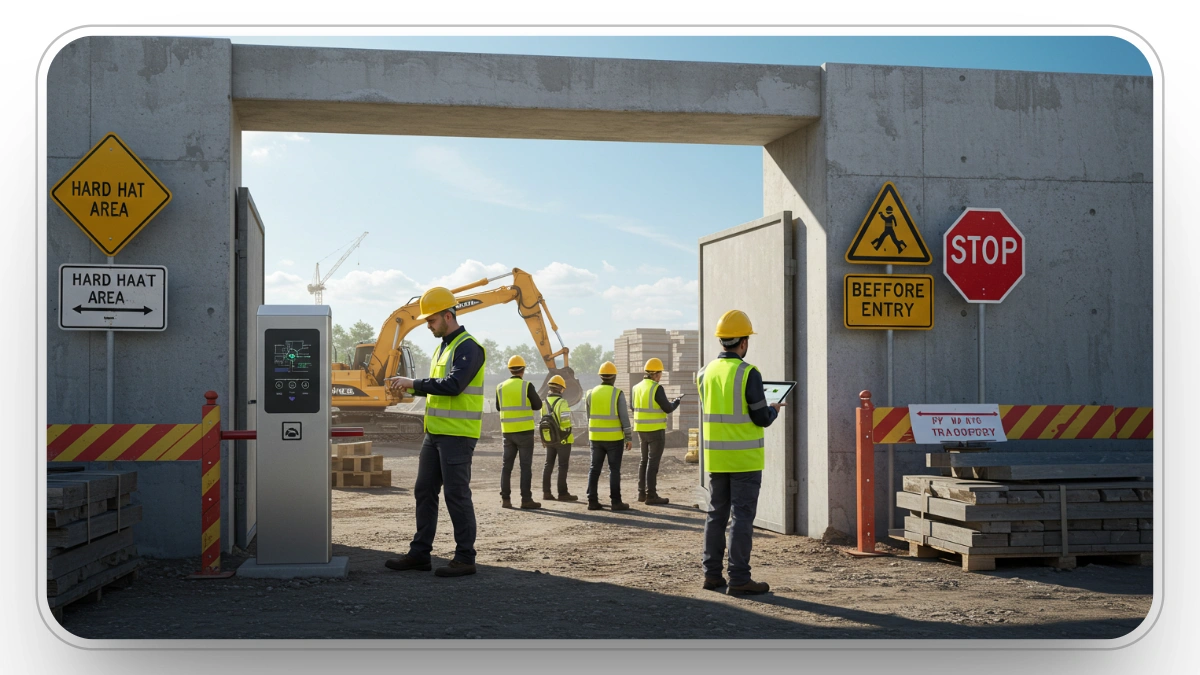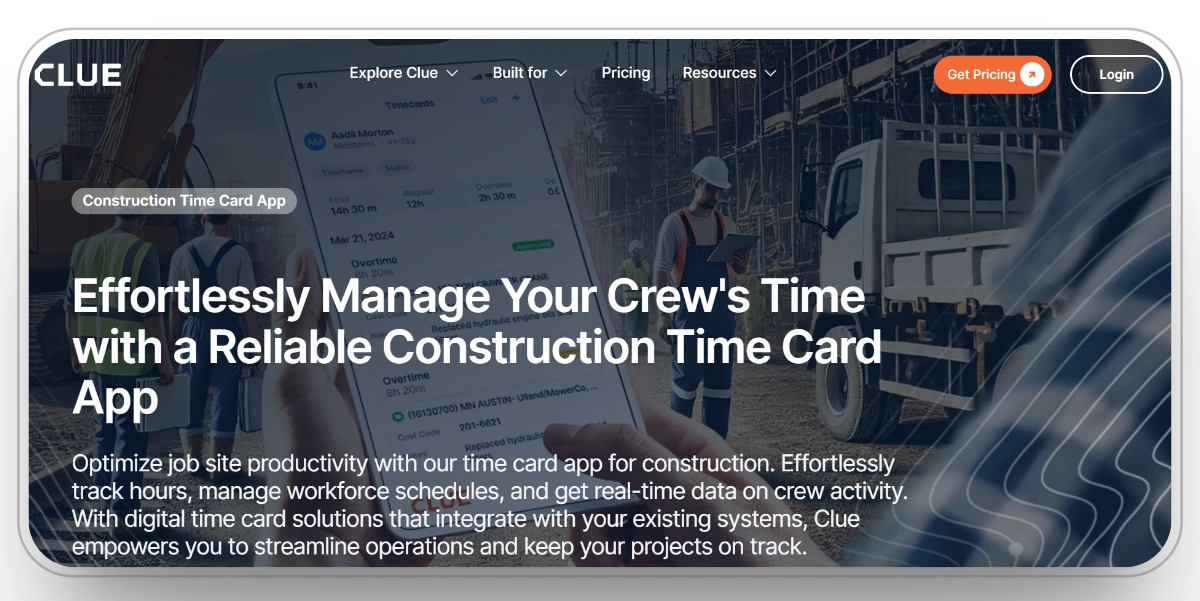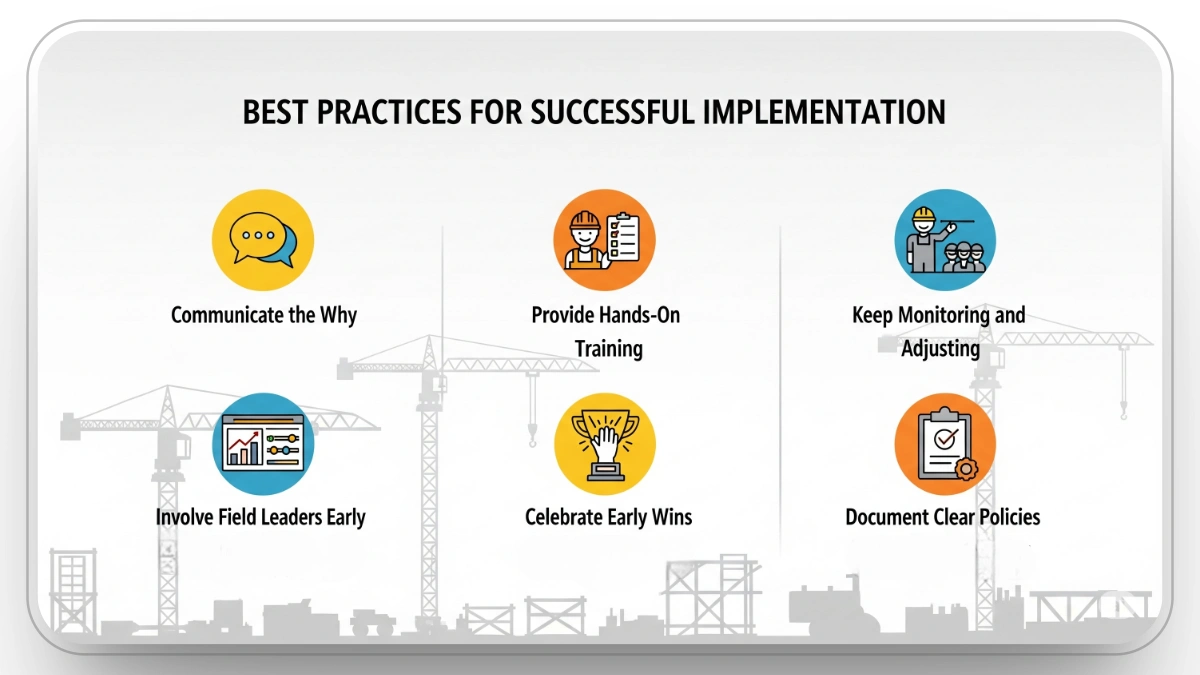What is Construction Workforce Tracking? Benefits and Challenges
Construction workforce monitoring refers to the real-time visibility of your workforce crew activities in terms of attendance, location, and productivity with the help of tools such as mobile applications, RFID badges and biometric scanners.
It is not merely digital timekeeping, when done right, it may reduce payroll errors by as much as 20%, avoid delays, enhance compliance, and remove payroll conflicts.
With the ability to replace manual time sheets with automated, independently verified observations you get a clear picture of who is on site, what they are working on and how effectively the crews are working.
Not only does this help streamline payroll and allocation of resources, but it also provides you with tangible data to build on, to predict labor needs, win more precise bids and keep on top of OSHA and labor law compliance.
Selecting an appropriate workforce tracking system has a direct effect on workforce cost control, payroll management, compliance, and project schedules, and this choice is, thus, a key decision that any construction company should make.
What is Construction Workforce Tracking?

The construction workforce tracking involves monitoring, tracking, and management of labor activity when in real-time terms, a worker arrives at the site through to the end of the day. It is basically a data-driven substitute to paper-based timesheets and clipboards and provides you with real-time information about what your team is doing, where they are located and whether they are doing it well.
Modern systems automatically capture and verify:
- Clock-in and clock-out times: Removes the possibility of manual input mistakes, salary claims and payments. Workers are compensated well based on real time spent on the field.
- Worker locations: Allows managers to allocate manpower to critical path activities to avoid bottlenecks and delays.
- Specific tasks or trades being performed: Lets managers match manpower to critical path tasks, preventing bottlenecks and delays.
- Certifications and training compliance: Flags workers who do not qualify to work before they engage in high risk jobs and minimize safety cases and Occupational Safety and Health Administration (OSHA) violations.
- Breaks, overtime, and absences: Allows you to be labor law compliant, manage effective overtime expenses, and real-time staffing needs adjustment.
How It Works on the Job
This is what the day of ordinary activities turns out to be with the workforce tracking system:
- Morning Check-In: Employees sign in with a mobile app, kiosk or badge. Their location is verified through this system to verify that they are on location.
- Data Sync: Hours, location, and crew assignments automatically update in a central dashboard.
- Midday Updates: Managers see real-time crew activity. If one team is ahead of schedule and another is falling behind, adjustments happen instantly.
- End-of-Day Reports: Time data flows straight to payroll and project management systems no re-entry, no mistakes.
This level of transparency turns labor from a “black box” into a measurable, controllable project resource.
Why Workforce Tracking Matters in Construction

Construction sites aren’t like office floors, workers are constantly moving, job scopes shift, and productivity can change by the hour. Without solid tracking:
- You’re estimating labor costs instead of knowing them.
- Scheduling conflicts are harder to solve.
- Overtime can spiral without anyone noticing.
- Compliance risks creep up, especially around safety and labor laws.
Workforce tracking puts you back in control by giving you a live, reliable view of your most critical resource: people.
The Benefits of Construction Workforce Tracking
According to insulation, 60% of contractors reported that 11% or more of field labor costs were wasted, and 79% believed they could achieve a 6% or greater productivity improvement with better management practices, such as improved tracking and planning
This is directly as a result of improved insight into staffing, quicker decision-making and more accurate information.
1. Boosting Efficiency and Productivity
Tracking the workforce by automation in timekeeping and by automatically entering mobile or badge-in clock-ins and updating to the cloud instead of manually entering it onto a computer.
This means hours of clerical work saved, and supervisors can remain on the front lines as well as being able to see in real-time any gaps in the workforce, allowing managers to get crews reassigned before the situation is spiraling out of control.
2. Improving Accuracy and Accountability
GPS-verified or site-based clock-ins remove location fraud and “buddy punching” and allow the creation of an unimpeachable record of hours worked.
This allows employees to receive proper compensation and prevents overpayments as well as the resolution of payroll issues more quickly and easily. While producing a more transparent organizational culture where all workers are held accountable.
3. Saving Money Without Cutting Corners
Labor data in real time seems idle crews, avoids unnecessary overtime, and maximizes staffing to allow the contractor to maintain labor lean without compromising schedules, with many finding the system to repay itself in months through reduced wastes and the avoidance of delays.
4. Planning Smarter With Real Data
Years or months of performance data can be tracked which enables the contractor to properly estimate their required crews, select the fastest teams to be matched to the appropriate work, and be able to accurately price future projects, preserving profit margins and maximizing win rates.
5. Strengthening Compliance and Safety
System-generated notifications and authorizations allow workers to be within the bounds of labor regulations, exclusively competent personnel accept potentially risky work assignments, and shift reports are saved and can be reviewed during an inspection or legal struggle, preventing the expense of OSHA fines and lawsuits.
6. Creating a Happier Workforce
Tracking systems boost morale with precise paychecks, easy-to-know schedules, quick and simple clock-ins, and less miscommunication about work to be done. Happy crews work harder, longer and better and tend to stay longer.
The Challenges of Workforce Tracking (and How to Solve Them)
.webp)
- Privacy Concerns: Workers could be apprehensive to be monitored. The fix must be disclosure of what and why anything is tracked, the limits on who gets tracked only during working hours and only when at the corresponding work sites, and secure communications with not just encrypting but also with protections like Illinois BIPA.
- Implementation Complexity: Implementing a new system will cause a disruption of business. To reduce it, begin with a pilot program on one site, offer explicit training to the supervisors and the crew and select offline tools on remote projects.
- Resistance to Change: Some people on the team like traditional means. Combat this by getting field leaders involved as early in the decision-making process as possible, emphasizing the direct advantages to workers like reduced payroll disputes and quicker clock-ins, and keep the technology easy and user-friendly.
- Cost Concerns: Scalable solutions have start-up costs as well. The recommended way is to start simple by focusing on the essential facilities (i.e., time and location tracking), and only after the benefits have been justified by the available data, consider uncovering more complex systems (i.e., analytics or access control).
Choosing the Right Workforce Tracking System
The choice of the proper workforce tracking system may directly influence the labor efficiency, payroll accuracy, and the profitability of the project generally.
Making the wrong selection wastes time, produces inaccurate data, and leaves crews frustrated, so it must be measured by performance, not by marketing promises.
- System integration: Integrate with Payroll, HR, Project management and ERP to avoid entering the same information and redundant errors.
- Data security: It has encryption, role-based access, labor and privacy laws.
- Offline capability: Function without internet and sync automatically when reconnected.
- Scalable pricing: Begin with necessary features and increase with the growth of your business.
Clue is an ideal software that brings all of the above behind a single platform, which is precise in time tracking, end-to-end integrations, secure management of data, and flexibility in deploying on any job site.
Clue’s Construction Time Card App

Clue's construction time card app is designed for contractors who require connected, accurate and real-time information of labor data, with the no-admin headaches of time cards.
It automates the process of recording time and can be integrated with inspection and work orders and provides managers with a real-time view of who is on every crew, and which job site (or sites).
How Clue Transforms Workforce Tracking on the Jobsite
Automated Time Tracking That Boosts Productivity
Our time card app offers an intuitive time-card feature that records work hours automatically like when checking in using a mobile device, GPS verification or badge swipes. This minimizes administration costs and repetitive data entry and managers always have the most current labor data.
Instant Payroll Sync to Eliminate Errors
The interaction of ERP directs all hours logged to go headfirst into payroll. Reduces work done in data entry, avoids uploading spreadsheets and comes up with the right pay-runs keeping the crews happy and avoiding costly payroll errors.
Simplified Field Management
Authorize time cards, check work orders and oversee inspections from any location. Clue allows superintendents to manage crews in real time to stop downtime, to move projects along.
Multi-Site Operations Under One Dashboard
Clue gives you a single pane of glass for all labor activity at all your sites whether you oversee two locations or twenty, and maintains consistent processes and performance standards across the business.
Timecards Linked to Inspections for Accountability
Clue integrates inspection logs with labor records, giving you the visibility to see exactly how many labor-hours went into an individual inspection, piece of equipment audit, or other compliance work, introducing transparency and enhancing oversight.
Work Order Integration for Better Scheduling
Managers can also track the amount of labor hours dedicated to a specific work order, thereby being able to effectively estimate the exact time it took to get a job done, determine the components of delays within the production process and move work groups in real time to limit the extent of delay.
One-Click Reporting for Audits and Reviews
Whether it comes in the form of safety inspections or job costing reports, all records are stored in a single place by Clue. You can create and see detailed reports and analytics in one simple click to audit, compliance check or internal performance review.
Compliance Without the Guesswork
Clue will automatically track overtime, breaks and even certification expirations, so every hour logged will be in compliance with labor regulations and OSHA.
Eliminating Time Theft
The mobile verification and GPS enable tracking so that only authorized workers can clock at the site. No “buddy punching”, no padded hours – now just simple accurate labor records.
Best Practices for Successful Implementation

An efficient workforce tracking system will never work even in the most sophisticated workforce tracking system when done in a bad way.
The successful implementation of the software requires more than a purchase of the software; it involves gaining, winning buy-in, and building confidence and the smooth integration of the system into the daily operations.
Adoption rates skyrocket when crews know how it conditions benefits, use it and leadership uses the system.
- Communicate the Why: When crews know the intent, when it means improvements in safety, fair wages, easing projects, they have a much greater likelihood of going along with the change.
- Provide Hands-On Training: Brief sessions that are held on-site are best. Before going live, let crews practice clocking in/out, and checking their assignments.
- Keep Monitoring and Adjusting: Ask feedback, monitor the rate of adoption and streamline processes. The idea is continuous improvement not a one and done setup.
- Involve Field Leaders Early: Working with esteemed foremen or supervisors who endorse the tool will increase the chances of the crews believing them and leading them.
- Celebrate Early Wins: Share stories of payroll disputes resolved, faster shift changes, or reduced overtime costs thanks to the new system. Recognition builds momentum.
- Document Clear Policies: Formulating easy-to-follow steps of simply clocking in/out, how to report breaks and what should be done in case of a malfunctioning system eliminates any ambiguity and excuses.
Final Thoughts
Construction workforce tracking is no longer just a software trend; it is becoming a competitive necessity. In an industry where labor costs and schedules can make or break profits, having accurate, real-time labor data is a game-changer.
Using the Clue workforce tracking system, you will be able to enhance productivity, cut down redundant expenses, enhance compliance and safe working conditions, and develop a more delighted workforce all in the same platform. It is the implementation that is different.
Where it is executed with care, using the right equipment, transparent communication, and your crew's buy-in, work force tracking becomes more than a management tool; instead it becomes a business growth tool.
Clue offers the technology and resources to get that transition as smooth as possible so your projects go more smoothly, your teams can remain focused, and your margins will be safe.
Transform Your Equipment Management











